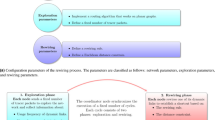Abstract
In autonomous networks, cooperations among nodes cannot be assumed, since each node is capable of making independent decisions based on their personal preferences. In particular, when a node needs the help of intermediate nodes to relay messages to other nodes, these intermediaries may be reluctant to contribute their network resource for the benefit of others. Ideally, the right amount of incentives should be provided to motivate cooperations among autonomous nodes so that a mutually beneficial network results. In this paper, we leverage the power of mechanism design in microeconomics to design a distributed incentive mechanism that motivates each node towards a more desirable network topology. Since network parameters and constraints change dynamically in reality, the desirable topology can vary over time. Our solution presented in this paper has successfully encompassed such a dynamic nature of the network topology. In addition, we have transformed our solution to an easy-to-implement distributed algorithm, that converges towards the globally optimal topology.
Similar content being viewed by others
References
L. Anderegg and S. Eidenbenz, Ad hoc-VCG: A truthful and cost-efficient routing protocol for mobile ad hoc networks with selfish agents, in: Proc. of the 9th ACM International Conference on Mobile Computing and Networking (ACM Mobicom, 2003) pp. 245–259.
L. Buttyan and J. Hubaux, Enforcing service availability in mobile Ad-hoc WANs, in: IEEE/ACM MobiHoc. 2000.
T. Gormen, C. Leiserson, R. Rivest and C. Stein, Introduction to Algorithms Chapt. 24 (The MIT Press, Cambridge, Massachusetts2001).
J. Feigenbaum, C. Papadimitriou, R. Sami and S. Shenker, A BGP-based Mechanism for Lowest-Cost Routing, in: Proceedings of ACM PODC (ACM Press, New York 2002) pp. 173–182.
J. Feigenbaum and S. Shenker, Distributed algorithmic mechanism design: Recent results and future directions, in: Proceedings of ACM Dial-M, (Atlanta, Georgia 2002).
A. Mas-Colell, M. Whinston and J. Green, Microeconomic Theory Chapt 23 (Oxford University Press, New York, 1995).
N. Nisan and A. Ronen, Algorithmic Mechanism Design, Games and Economic Behavior, 35 (2001) 166–196.
C. Papadimitriou, Algorithms, games, and the internet. in: Proceedings of STOC (Crete, Greece 2001).
T. Roughgarden, Selfish routing. PhD thesis, Cornell University (2002) http://www.cs.berkeley.edu/timr/papers/thesis.pdf
V. Srinivasan, P. Nuggehalli, C. Chiasserini and R. Rao, Cooperation in wireless ad hoc networks, in: Proceedings of INFOCOM (2003).
Author information
Authors and Affiliations
Corresponding author
Additional information
Selwyn Yuen obtained his BASc from the University of Waterloo Systems Design Engineering in 2002. He subsequently joined the Department of Electrical and Computer Engineering at the University of Toronto, where he completed his MASc in Computer Engineering in 2004. His Master thesis focuses on applying game theory and mechanism design in peer-to-peer and wireless networks. His other research interests include Artificial Intelligence, Optimization, Network Protocol Design, Distributed Algorithms, Operating Systems, as well as modelling and simulation of the Stock Market.
Baochun Li received his B.Engr. degree in 1995 from Department of Computer Science and Technology, Tsinghua University, China, and his M.S. and Ph.D. degrees in 1997 and 2000 from the Department of Computer Science, University of Illinois at Urbana-Champaign. Since 2000, he has been with the Department of Electrical and Computer Engineering at the University of Toronto, where he is currently an Associate Professor and holds the Bell University Laboratories Endowed Chair in Computer Engineering. In 2000, he was the recipient of the IEEE Communications Society Leonard G. Abraham Award in the Field of Communications Systems. His research interests include application-level Quality of Service provisioning, wireless networks, and overlay networks.
Rights and permissions
About this article
Cite this article
Yuen, S., Li, B. Strategyproof Mechanisms towards Dynamic Topology Formation in Autonomous Networks. Mobile Netw Appl 10, 961–970 (2005). https://doi.org/10.1007/s11036-005-4452-6
Published:
Issue Date:
DOI: https://doi.org/10.1007/s11036-005-4452-6




